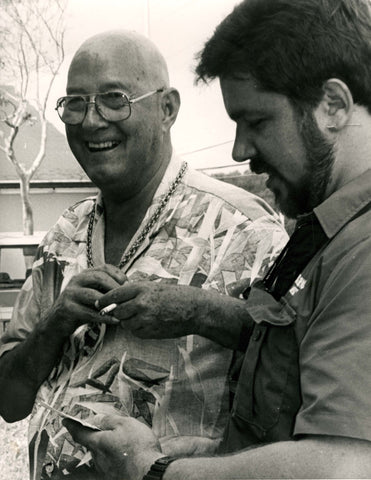
Nuestra Señora de Atocha 1622
The most famous Spanish galleon discovery in history
“TODAY’S THE DAY!” That was the phrase Mel Fisher used to tell his divers every day, for 16 years, while he led them on a search through the waters off Key West, Florida for the elusive Spanish galleon, Nuestra Senora de Atocha.
Atocha was the almiranta (rear guard ship) of the 1622 Treasure Fleet, which left Havana several weeks late, causing them to run into the jaws of a hurricane on September 6, 1622. Eight ships of the 28-ship fleet were lost, wrecked on the reefs between the Dry Tortugas and present day Key West. Only five people survived from Atocha and were saved by another vessel. The wreck itself was scattered after another hurricane hit the site exactly one month later, so the Spanish were never able to salvage what was one of the richest galleons ever to sail. PHOTO: Robert with Mel Fisher at a museum opening in Key Largo, 1991.
No human eyes saw the treasure again, until Mel Fisher began to pick up pieces of her King’s ransom in precious cargo in 1971. Six years into the search he lost his eldest son, Dirk, Dirk’s wife, Angel, and crew member Rick Gage when their salvage vessel, Northwind, capsized. But that wasn’t the only hardship Fisher and his crew had to endure. The government didn’t care when Fisher lost family members, but when he started to find pieces of Atocha’s treasure, they swooped in and claimed it all for themselves! After eight years of expensive legal battles, the U.S. Supreme Court ruled in favor of Fisher on July 1, 1982. But Atocha’s “mother load” still eluded the salvors, and through it all, Fisher and his crew persisted with dogged determination. Then, on July 20th, 1985, ten years to the day of the Northwind tragedy, Mel Fisher’s words rang true! He and his crew discovered the “mother load” of Atocha’s vast treasure, by some estimates, worth over $400 million! The court ordered 25 percent be turned over to the State of Florida, but Fisher and his backers could keep the rest.
Most of the coins recovered from Atocha were minted in the New World mints of Potosi, Upper Peru (present day Bolivia), and Mexico City, New Spain (present day Mexico), during the reigns of Philip II (1556-1598) and Philip III (1598-1621). They bear a simplified Hapsburg shield on the obverse. The legend, if complete, reads “PHILIPPVS II (III) DEI GRATIA,” meaning “Philip II (III) by the Grace of God.” The reverse has a cross with castles and lions in the quarters, signifying the union of the two Iberian Peninsula kingdoms of Leon and Castile, which united in 1301 and began the Reconquista of Iberia from the Moors, the Muslim rulers who had invaded from North Africa in 711. The legend reads “HISPANIARVM ET INDIARVM REX, “King of Spain and the Indies.”
Atocha is hailed as the most famous Spanish galleon of our time, and you now own a piece of that history, when kings ruled the land, and pirates ruled the seas!
Personal Note from Robert: A year before I was born in Crescent City, CA, my mother took SCUBA lessons from Mel (in Redondo Beach, CA) and bought a gold dredge that she and my dad used in the rivers in northern California. Many years later, I recovered treasure and dived on the galleons that were a part of the 1715 Spanish Treasure Fleet off Vero Beach, Florida. The lease was owned by none other than Mel Fisher. He gave a hearty laugh when I told him the story!
Mel passed in 1998, but his family continues the search. While Atocha’s main cargo of silver coins was discovered in 1985 and has been salvaged over the years, the stern castle and captain’s cabin, where the gold bars and Muzo mine emeralds would have been stored, still eludes search teams to day. And I swear, if you are ever in Key West looking out over the waters where Atocha lies, you can hear Mel whisper, “Today’s the day!” wafting on the warm island breezes.
To shop our collection of Rare Atocha coins and coin jewelry, click here>
